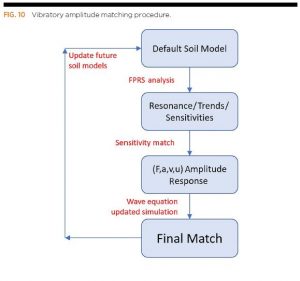Frequency-Penetration Response Spectrum on Vibratory Amplitude Matching of Monopiles
Titel |
Frequency-Penetration Response Spectrum on Vibratory Amplitude Matching of Monopiles |
 Signal Matching for Vibro Driven piles |
Author(s) |
N. Moscoso del Prado Mazza & A.E. Holeyman |
|
Year |
2018 |
|
Language |
English |
|
Where |
10th Int Stress Wave Conference, San Diego, USA |
|
Cite as |
Mazza, N. M. D. P. and Holeyman, A. E., 'Frequency-Penetration Response Spectrum on Vibratory Amplitude Matching of Monopiles,' Stress Wave Theory and Testing Methods for Deep Foundations: 10th International Conference, ASTM STP1611, P. Bullock, G. Verbeek, S. Paikowsky, and D. Tara, Eds., ASTM International, West Conshohocken, PA, 2019, pp. 468–492, http://dx.doi.org/10.1520/STP161120170243 |
ABSTRACT:
The development of offshore windfarms is increasing exponentially, and this trend is expected to last for at least 20 years. Vibratory driving is anticipated to challenge impact driving once fully developed. This would result in high-speed installation and cost reduction. Research on vibratory driving prediction and vibratory amplitude matching is still scarce, preventing the emergence of conclusive trends. Thus, this paper aims to promote vibrodriving understanding using various approaches, including dedicated wave equation simulation software. In such simulated models, a vibratory hammer generates a sinusoidal force applied at the head of the pile that propagates as a stress wave through the pile according to one-dimensional stress wave theory. The pile is discretized into small segments to implement, e.g., the method of characteristics solution.
At the ends of each pile segment (interfaces), the generated sinusoidal force interacts with soil resistances. Force and velocity amplitudes as well as penetration speeds are the main focus of simulated or measured vibrodriving cases. These amplitudes integrate vibrator forces, mobilized soil resistances, and other effects. Soil resistances could possibly be extracted from these results, allowing one to characterize soil dynamic behavior and quantify soil parameters. Due to the periodic nature of the vibratory installation technique, frequency models are beneficial in spotting specific behaviors of the vibrated pile such as resonance and anti-resonance. A tool is presented herein to characterize these phenomena: the frequency-penetration response spectrum. This tool intends to enhance vibrodriveability predictions by covering a larger range of possible scenarios because current vibrators cannot always maintain a constant frequency during driving. Identifying critical or optimal frequencies is the primary objective of this paper.
DOWNLOAD:
You can download the entire article here after entering your name and e-mail address:



